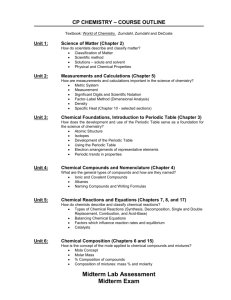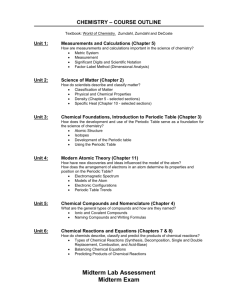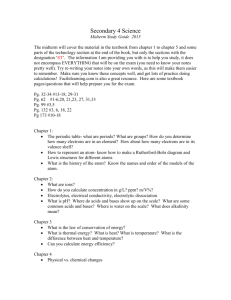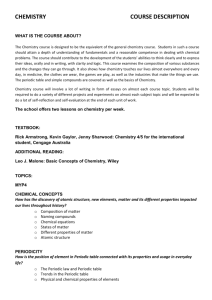CHEM 103(General Chemistry I)
advertisement
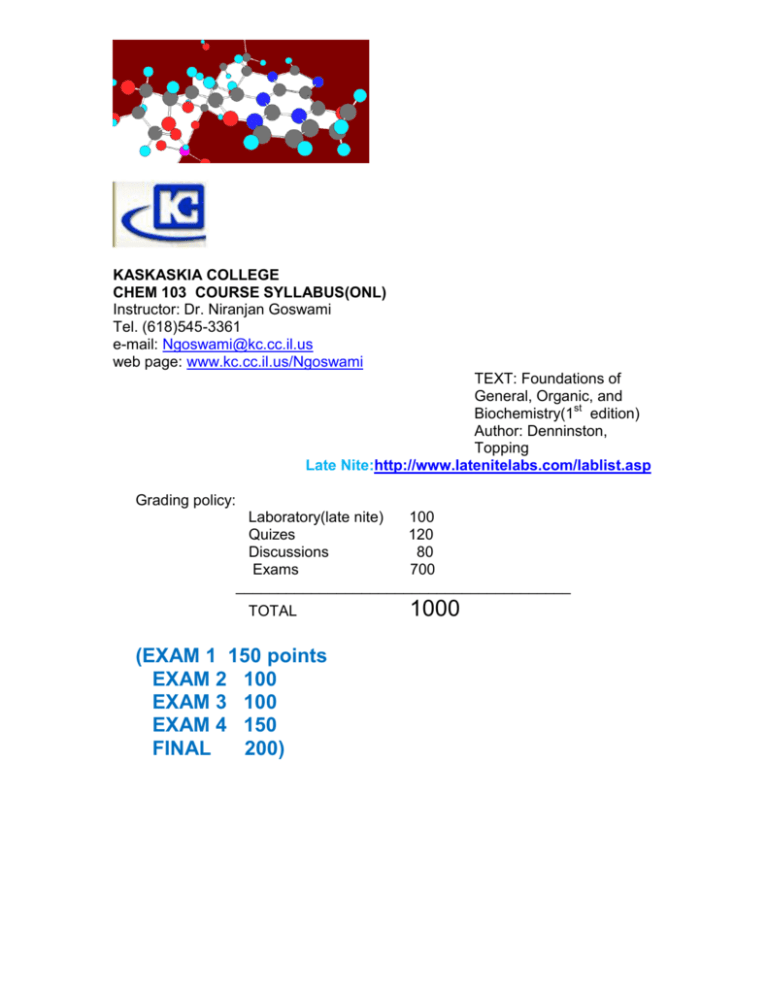
KASKASKIA COLLEGE CHEM 103 COURSE SYLLABUS(ONL) Instructor: Dr. Niranjan Goswami Tel. (618)545-3361 e-mail: Ngoswami@kc.cc.il.us web page: www.kc.cc.il.us/Ngoswami TEXT: Foundations of General, Organic, and Biochemistry(1st edition) Author: Denninston, Topping Late Nite:http://www.latenitelabs.com/lablist.asp Grading policy: Laboratory(late nite) 100 Quizes 120 Discussions 80 Exams 700 ________________________________________ TOTAL (EXAM 1 150 points EXAM 2 100 EXAM 3 100 EXAM 4 150 FINAL 200) 1000 Scores 900-1000 800-899 700-799 600-699 <600 Letter grade A B C D F OBJECTIVES OF THE COURSE 1. provide the student with a brief overview of chemistry. 2. introduce the student to the fundamental methodology of Chemistry. 3. introduce the student to some of the basic principles of Chemistry. 4. introduce the student to the equipment in a chemistry lab. 5. introduce the student to some of the basic laboratory manipulation in the chemistry laboratory . 6. provide a basis for further courses requiring knowledge of chemistry. 7. introduce the students to basic principles of organic chemistry. Exams: There will be 5 exams total. The final Exam is comprehensive. Every one must pass the Late Nite Lab(must obtain 70% in the Late Nite Lab alone) in order to pass in the class. Exams, Quizes and Lab Assignments: Please find their schedule by clicking Assessments and Assignments on your blackboard. Learning Objectives: Getting familiar with the elements and the periodic table. Understanding the electronic configurations of elements based on the atomic structure. To understand the organization of elements in the periodic table. To understand chemical bonding and structure with various molecular properties, writing chemical compounds and chemical equations and chemical equilibria. Learning how to balance chemical reactions with stoichiometric calculations. Also, to understand about the units and scientific measurements. To learn intermolecular interactions and solid, liquid, and gaseous state behavior of chemical compounds. To understand the ionization of chemical compounds, nature of acids and bases with pH calculations. Getting into the laboratory techniques in chemistry with understanding hypothesis and experimental design. Understanding nuclear reactions with the nature and application of radioactivity. Getting familiar with the chemistry at Carbon (organic chemistry). Be able to know some practical applications of chemistry in various ways. COURSE DESCRIPTION Chapter 1: Chemistry: Methods and Measurement: Discovery process, Chemical physical properties, hypothesis, major areas of chemistry,units of measurements, significant numbers, volumes, density and specific gravity. Chapter 2: The Composition of the Structure of Atom. Subatomic particles, Dalton’s theory, The relationships between light and atomic structure, the Bohr atomic model, Modern atomic theory, orbital and electron density, atomic number, mass number, isotopes, atomic mass unit. Getting familiar with the periodic table and periodic trend or variation of periodic properties (atomic radii or size and ionization energy), classification of elements. quantum numbers, electronic configuration, Pauli exclusion principles, Aufbau principles, Hund’s rule of multiplicity, the octet rule. Chapter 3 : Chemical bonding and structures: Valence electrons, electron dot structures, resonance structures, ionic and covalent compounds, cations and anions, naming and writing formulas, polyatomic anions and cations, hybridization, geometry, bond polarity and electronegativity, and bond angles and their variations (Valence Shell Electron Repulsion Theory(VSEPR), blood pressure and Na+/K+ Chapter 4:Calculations and the Chemical Equation: Mole, molarity, chemical calculations, stoichiometric calculations(calculations using chemical equations), theoretical and percent yield, writing balanced equations Chapter 5:Energy, Rate, and Equilibrium: Thermochemical reactions, enthalpy, entropy and free energy, chemical equilibrium, potential energy diagrams, factors affecting chemical equilibrium. ________________________________________________________________________ Chapter 6:States of Matter: Molecules in motion:Gas laws, Vapor pressure of a liquid, Molecular interactions in liquids and solids, boiling point, vaporization. Homework: will be assigned later. ~~~~~~~~~~~~~~~~~~~~~~~~~~~~~~~~~~~~~~~~~~~~~~~~~~~~~~~~~~~~~~~~~~~~~ Chapter 7: Reactions and Solutions: Writing Chemical Reactions, Types of chemical reactions, different types of solutions, Hydrogen bonding and water, boiling point, vaporization, evaporation, solvation, % calculation, molarity and calculations, electrolytes in body fluids. ________________________________________________________________________ Chapter 8: Acids, Bases, Salts, and Buffers: Acids and bases, ionization, and neutralization, strong and weak acids and bases, pH calculations and equilibrium constant. Buffers, normality calculations, oxidation-reduction reactions and electrochemical cells. ~~~~~~~~~~~~~~~~~~~~~~~~~~~~~~~~~~~~~~~~~~~~~~~~~~~~~~~~~~~~~ Chapter 9: The Nucleus, Radioactivity, and Nuclear Medicine:Natural radioactivity, writing nuclear reactions, properties and uses of radioisotopes Homework: will be assigned later. ________________________________________________________________ Chapter 10:The Chemistry of Carbon: Differences between organic and inorganic compounds, families of organic compounds, alkanes, alkenes, and alkynes, nomenclature of organic compounds, functional groups and their properties, aromatic compounds, introduction to biological molecules and their role. ~~~~~~~~~~~~~~~~~~~~~~~~~~~~~~~~~~~~~~~~~~~~ LEARNING OUTCOMES 1. understand the scientific methods and show how experiments are related to these methods. They should be able to memorize and understand the conversion factors of units of measurements including their uses in the related experiments. 2. understand the applications and importance of significant numbers. 3. define matter, element, atom, molecule, and compound and distinguish between them giving examples. 4. distinguish between chemical and physical changes giving examples. 5. describe atomic structures giving examples. They should be able to define atomic number and mass number and how are they indicated in the symbols. 6. understand and memorize four quantum numbers and how they are related to the energy levels and sublevels or orbitals. 7. understand and memorize Aufbau principle, Hund's rule of multiplicity, and Pauli-Exclusion principle and their use in the Electronic configurations. 8. distinguish between orbits and orbitals. Discuss the electronic configuration of the first 30 elements in the periodic table. 9. identify the covalent and ionic bonds with examples. Identify and memorize the polyatomic anions and cations. 10. understand the periodic properties of elements and discuss the position of elements in the periodic table including the periodicity or periodic variations. 11. draw the lewis-dot structures of atoms, ions, and covalent compounds. 12. understand hybridizations of orbitals and identify the variation in the bond angles, geometry, and polarities of the compounds. 13. understand the concept of mole, and molarity. Calculate the number of moles from the number of grams. Calculate the number of molecules from the number of moles and grams (using Avogadro's number). 14. balance the chemical reactions and show their stoichiometric calculations. 15. learn how to calculate the % of any element or compound. 16. learn to calculate the number of molecules or ions in a mole of the compound. 17. differentiate between acids and bases and (both Bronsted-Lowry and Lewis concept) with examples. 18. differentiate between strong acids and bases and weak acids and bases with examples and their dissociation in aqueous systems. 19. understand the definition of pH and their relationships and how to calculate the pH and pOH of different solutions containing acids and bases. 20. learn how to write the balanced chemical reactions involving acids and bases. 21. understand the titrations of acids with bases and their importance in Analytical Chemistry. 22. understand the mechanism of hydration of polar and non-polar compounds and their differences. Should be able to understand the surface tension and viscosity and other properties of liquids. 23. understand the nuclear reactions, nuclear isotopes, their application and half-life calculations. 24. identify the bonding and structure of organic compounds, their nomenclature and some important reactions. 25. understand and memorize the units of temperature, pressure, and volume 26. understand the ideal gas laws including the Boyle's law, Charles's law, the combined gas law, and ideal gas laws and should be able to calculate the pressure, volume,temperature form the gas laws. 27. understand the differences between physical and chemical changes in the laboratory. 28. identify qualitataively the presence of cations and anions by some reactions with positive observations. 29. understand the distillation process and should be able to perform experiments showing the distillation of some liquids. 30. understand the hypothesis, experimental design, results and conclusion in chemical studies. Laboratory Experiments(Late Nite Labs) 1. Characteristic Properties-Melting and Boiling Points 2. Conservation of Mass 3. Empirical Formulas of Hydrate 4. Empirical Formula of Copper Oxide 5. Identifying Halide ions 6. Avogadro’s Law 7. Boyle’s Law 8. Buffers 9. pH Indicators 10. The temperature Dependence of Salt Solubility 11. Precipitation Titration 12. Qualitative Analysis 13. Vitamin C Content of juices 14. Spectrophotometry 15. Stoichiometry 16. Chemical Equilibria


